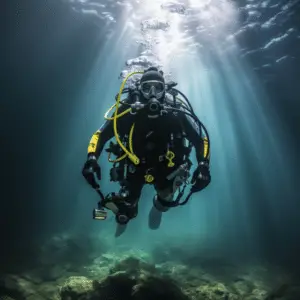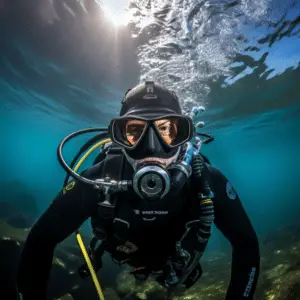
As Dive Gear, we know the importance of having top-notch gear. But when should you replace it? It depends on various factors. Here, we’ll explore those factors.
Type of gear is a key consideration. Wetsuits and masks may need to be replaced more often due to use. BCDs and regulators, with proper maintenance, can last longer. Inspect your gear regularly for damage or malfunction.
Frequency of use matters too. If you dive often, your gear will experience more wear. So, frequent divers should keep a close eye on their equipment and be ready for replacements.
Maintenance is crucial for extending gear lifespan. Follow manufacturer guidelines for cleaning and storing. Rinse after each dive and store in a cool, dry place. Have your gear serviced by a certified technician regularly.
According to Scuba Diving Magazine, regulators should be replaced every 7-10 years, depending on usage and maintenance. Different pieces of gear have varying replacement intervals.
Why is it important to replace dive gear regularly?
Replacing dive gear is essential for diver safety and optimal underwater performance. Saltwater, UV rays, and wear and tear take a toll on gear, reducing its reliability. Replacing it stops equipment failure and accidents.
Plus, replacing dive gear keeps divers up-to-date with advancements. Better designs, materials, and features improve comfort and durability. Divers can choose the best gear for them.
Regularly replacing dive gear also allows divers to change their gear based on preferences or experience. They can adjust their equipment to better suit them.
Pro Tip: Follow manufacturer guidelines for replacing specific components like regulators or O-rings. This maintains performance and reduces the risk of malfunctions.
Factors to consider when determining how often to replace dive gear
Dive gear is a must for divers, however working out when to replace it can be tricky. Various elements influence the lifespan of dive gear. Quality of materials, maintenance and care, and frequency of use all impact how long the gear lasts.
Certain dive gear components, like masks or snorkels with elastic straps or hoses, might need replacing more often due to exposure to saltwater. Being aware of these components helps avoid potential problems.
Here’s a pro tip: Check your dive gear regularly to spot any wear and tear. This will help address issues quickly and keep your gear safe and performing well under water.
Signs that indicate it’s time to replace your dive gear
Your dive gear is essential for underwater adventures. Knowing when to replace items is necessary for safety and a great dive experience. Here are signs it’s time to retire your gear:
- Thinning material or loose seams on a wetsuit can reduce insulation and cause hypothermia.
- Cracks or discoloring on a mask lens will hinder vision underwater.
- Air leaks or inconsistent airflow from a regulator can be dangerous. If you spot irregularities, get a new one.
- Fins should be flexible and crack-free for optimal performance. If not, invest in a new pair.
- A dive computer that malfunctions or provides inaccurate data should be upgraded.
Age and tech advances should also be taken into account. One diver had an incident due to not checking their gear. The mask cracked underwater due to wear and tear. So, safety should be top priority and any damaged items should be replaced quickly. That way, you can explore the underwater world with peace of mind.
How to properly maintain dive gear to prolong its lifespan
Maintaining dive gear is very important to ensure that it lasts. Not doing so can put you in danger when diving. Here are 4 steps to keep your gear in great condition:
- Rinse: After each dive, rinse with fresh water. Clean the regulator, BCD and mask straps. Use mild detergent if needed, but don’t use harsh chemicals.
- Dry: Allow air drying before storing. Hang wet suits and BCDs in a ventilated area away from the sun. Use a specialized drying cap for regulators.
- Store: Find a clean and dry storage place. Keep everything organized and don’t put heavy objects on delicate items.
- Service: Have regular checks by certified technicians. Inspect O-rings, clean valves, and test pressure gauges. This helps with safety and can spot issues before they become serious.
Additionally, check for wear and damage before each dive and replace any parts that aren’t working right. Take good care of your gear for a safer and longer-lasting dive. Enjoy peace of mind knowing that your gear is reliable and well-maintained. Dive safely and make it count!
Common misconceptions about replacing dive gear
Confusion abounds about when to switch out dive gear. Let’s clear up some common misunderstandings:
- Misconception #1: Dive gear must be swapped out annually.
- Misconception #2: New-looking gear doesn’t need replacing.
- Misconception #3: Only ruined gear must be replaced.
- Misconception #4: It’s alright to keep using outdated tech.
- Misconception #5: Gear substitution is only required for expert divers.
It’s vital to remember that the life expectancy of dive gear depends on several elements such as frequency of use, upkeep, and manufacturer advice. Inspecting and servicing regularly are paramount to make sure your apparatus is both secure and functional.
Besides, it’s key to stay informed of the most up-to-date advances in dive gear tech. Even if your gear looks okay, there could be newer models out there with enhanced features that can improve your diving experience.
To reiterate, safety should always come first when diving. Investing in quality gear and replacing it when necessary is an investment in your well-being.
Pro Tip: Talk to a certified dive expert who can evaluate the state of your gear and provide tailored suggestions for replacing it based on your individual needs.

Conclusion
Replacing dive gear is key for safety and efficiency underwater. Neglecting to do so could lead to equipment malfunctions or failures, risking divers’ lives. Heed manufacturer’s recommendations and inspect gear regularly to maintain it well.
Several things come into play when replacing dive gear. Diving frequency, saltwater or harsh conditions, and good upkeep all help decide when to replace. For example, those who dive in saltwater often may need to replace gear more, due to salt’s corrosive nature.
Gear lifespan differs too. Fins and masks may last longer with care, but regulators and BCDs (buoyancy control devices) may need more frequent replacement, because of wear on parts.
A perfect example of why gear maintenance is crucial is the sad story of a diver. Warnings about his faulty regulator were ignored. During a deep dive, the regulator malfunctioned, causing a fatal accident. This shows how vital proactive maintenance and timely replacements are.
Frequently Asked Questions
FAQ #1: How often should you replace your dive gear?
Answer: The lifespan of dive gear varies depending on several factors such as usage, maintenance, and the type of equipment. However, a general guideline is to replace your dive gear every 5-10 years. Regular inspections and servicing can help identify any issues or wear and tear that may require earlier replacements.
FAQ #2: What are some signs that indicate the need for replacing dive gear?
Answer: Signs that may indicate the need for replacing dive gear include noticeable wear and tear, corrosion, cracks, frayed straps, and malfunctioning components. If you experience any equipment failures or if your gear doesn’t feel safe or reliable during dives, it is advisable to replace it sooner rather than later.
FAQ #3: Can I extend the lifespan of my dive through proper maintenance?
Answer: Absolutely! Proper maintenance can significantly extend the lifespan of dive. Rinse your equipment with fresh water after each dive, dry it thoroughly, and store it in a cool, dry place away from direct sunlight. Regularly inspect and service your gear as recommended by the manufacturer or a certified technician to ensure it remains in good working condition.
FAQ #4: Should I replace my dive if it has not been used frequently?
Answer: Yes, even if your dive gear has not been used frequently, it still requires regular maintenance and replacement over time. Materials deteriorate and components may fail due to age or lack of use. It’s important to remember that dive gear is critical for your safety underwater, regardless of how often it has been used.
FAQ #5: Are there any specific regulations or standards that determine when dive should be replaced?
Answer: While there are no specific global regulations dictating when dive should be replaced, many manufacturers provide guidelines based on factors like age, hours of use, and servicing recommendations. It is essential to follow the manufacturer’s guidelines and consult with certified technicians or instructors who can provide expert advice based on industry standards.
FAQ #6: Can I sell or donate my used dive?
Answer: Yes, you can sell or donate your used dive provided that it is still in good working condition and meets safety standards. Before selling, ensure that it has been properly serviced and inspected. When donating, consider organizations or individuals who may benefit from your gear, but always verify their requirements and condition expectations.
